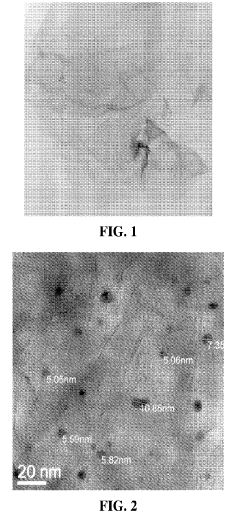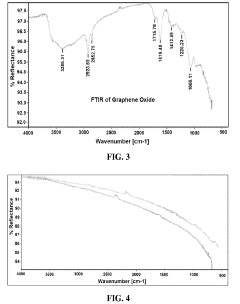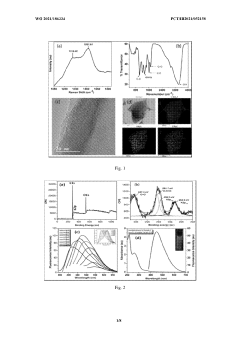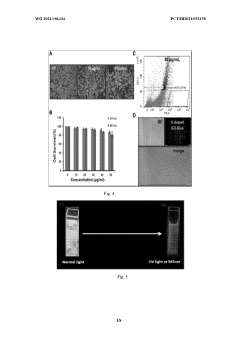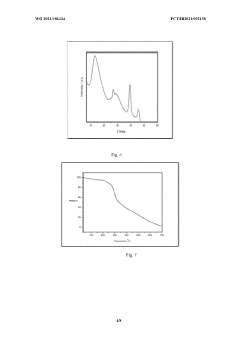Graphene Oxide: Key Role in the Development of Solar Cells
Graphene Oxide Solar Cell Evolution and Objectives
Graphene oxide has emerged as a revolutionary material in the field of solar cell technology, marking a significant milestone in the evolution of photovoltaic devices. The journey of graphene oxide in solar cell development began with the discovery of graphene's exceptional properties, including its high electrical conductivity and optical transparency. As researchers delved deeper into graphene's potential, they recognized the unique advantages of its oxidized form, graphene oxide, in enhancing solar cell performance.
The primary objective in integrating graphene oxide into solar cells is to overcome the limitations of traditional silicon-based photovoltaic technology. Researchers aim to improve energy conversion efficiency, reduce production costs, and enhance the durability and flexibility of solar panels. Graphene oxide's role in this endeavor is multifaceted, serving as a promising material for various components within the solar cell structure.
One of the key goals is to utilize graphene oxide as an electron transport layer, leveraging its excellent charge carrier mobility to facilitate efficient electron collection and transfer. This application has the potential to significantly reduce recombination losses and improve overall cell efficiency. Additionally, researchers are exploring graphene oxide's potential as a transparent electrode, aiming to replace conventional indium tin oxide (ITO) with a more cost-effective and flexible alternative.
Another critical objective is to harness graphene oxide's unique optical properties to enhance light absorption within the solar cell. By incorporating graphene oxide into the active layer or as an interface modifier, scientists seek to broaden the spectrum of light that can be effectively captured and converted into electrical energy. This approach holds promise for pushing the theoretical efficiency limits of solar cells beyond current thresholds.
The evolution of graphene oxide in solar cell technology has been marked by continuous refinement of synthesis methods and integration techniques. Early research focused on understanding the fundamental properties of graphene oxide and its interactions within solar cell architectures. As the field progressed, efforts shifted towards optimizing the material's composition, morphology, and functionalization to tailor its properties for specific solar cell applications.
Looking ahead, the objectives for graphene oxide in solar cell development are ambitious and far-reaching. Researchers are working towards developing large-scale, cost-effective production methods for high-quality graphene oxide, a crucial step in commercializing graphene oxide-based solar technologies. There is also a strong focus on creating hybrid materials that combine graphene oxide with other advanced materials to synergistically enhance solar cell performance.
Market Demand for Advanced Solar Cell Technologies
The global solar energy market has been experiencing significant growth, driven by increasing environmental concerns, government incentives, and the declining costs of solar technologies. Within this expanding sector, there is a growing demand for advanced solar cell technologies that can offer higher efficiency, improved durability, and cost-effectiveness. Graphene oxide, with its unique properties, has emerged as a promising material in the development of next-generation solar cells.
Market research indicates that the global solar photovoltaic (PV) market is projected to reach substantial growth in the coming years. This growth is fueled by the increasing adoption of renewable energy sources and the push for sustainable development across various industries. As traditional silicon-based solar cells approach their theoretical efficiency limits, there is a pressing need for innovative materials and technologies to overcome these limitations and meet the rising energy demands.
The demand for advanced solar cell technologies is particularly strong in regions with high solar irradiance and ambitious renewable energy targets. Countries such as China, the United States, India, and several European nations are investing heavily in solar energy infrastructure and research. These markets are actively seeking solutions that can improve the performance and reduce the cost of solar power generation.
In the context of graphene oxide-based solar cells, there is a growing interest from both the scientific community and industry players. The potential of graphene oxide to enhance the efficiency of solar cells, improve their stability, and potentially reduce manufacturing costs has attracted significant attention. This interest is reflected in the increasing number of research publications, patent applications, and collaborations between academic institutions and commercial entities focused on graphene oxide applications in photovoltaics.
The market demand for graphene oxide in solar cell development is closely tied to the broader trends in the advanced materials sector. As the production processes for graphene oxide become more scalable and cost-effective, its potential for commercial application in solar cells becomes more viable. This has led to increased investment in research and development activities aimed at optimizing graphene oxide-based solar cell technologies for mass production.
Furthermore, there is a growing demand for flexible and lightweight solar cells for integration into building materials, portable electronics, and wearable devices. Graphene oxide's unique properties make it particularly suitable for these applications, potentially opening up new market segments and driving further demand for advanced solar cell technologies.
However, it is important to note that the market demand for graphene oxide-based solar cells is still in its early stages. While the potential benefits are significant, the technology must overcome several challenges, including scalability, long-term stability, and cost-competitiveness with existing solar technologies, to achieve widespread commercial adoption. As these challenges are addressed, the market demand for graphene oxide in solar cell applications is expected to grow, potentially reshaping the landscape of the solar energy industry.
Current Challenges in Graphene Oxide Solar Cell Development
Despite the promising potential of graphene oxide in solar cell development, several significant challenges currently hinder its widespread adoption and commercialization. One of the primary obstacles is the difficulty in achieving consistent and scalable production of high-quality graphene oxide sheets. The synthesis process often results in variations in sheet size, thickness, and defect density, which directly impact the material's electronic properties and overall solar cell performance.
Another major challenge lies in the integration of graphene oxide into existing solar cell architectures. While graphene oxide shows excellent potential as a transparent electrode or charge transport layer, incorporating it effectively into multi-layer solar cell structures without compromising the performance of other components remains a complex task. Issues such as interfacial compatibility and charge transfer efficiency between graphene oxide and adjacent layers need to be addressed to maximize overall device efficiency.
The stability of graphene oxide in solar cell applications is also a significant concern. Graphene oxide is known to be sensitive to environmental factors such as humidity and temperature, which can lead to degradation of its properties over time. This instability can result in reduced solar cell lifespan and performance deterioration, making long-term reliability a critical challenge for commercial viability.
Furthermore, the optimization of graphene oxide's optoelectronic properties for solar cell applications presents ongoing difficulties. While graphene oxide offers high transparency and conductivity, fine-tuning these properties to achieve the ideal balance for specific solar cell designs remains a complex task. Researchers are still working on methods to precisely control the oxygen content and defect structure of graphene oxide to optimize its band gap and charge carrier mobility for solar energy harvesting.
The cost-effectiveness of graphene oxide-based solar cells is another hurdle that needs to be overcome. Although graphene oxide itself is relatively inexpensive to produce, the additional processing steps and specialized equipment required for its integration into solar cells can significantly increase overall manufacturing costs. Developing economically viable production methods that maintain material quality while reducing costs is crucial for the commercial success of graphene oxide solar cells.
Lastly, there is a need for standardization in graphene oxide characterization and quality control methods. The lack of universally accepted standards for assessing graphene oxide properties and performance in solar cell applications makes it challenging to compare results across different research groups and evaluate progress in the field. Establishing standardized protocols for material characterization and device testing is essential for accelerating the development and commercialization of graphene oxide-based solar technologies.
Existing Graphene Oxide Solar Cell Architectures
01 Synthesis and production methods of graphene oxide
Various methods for synthesizing and producing graphene oxide are described, including chemical exfoliation, oxidation of graphite, and reduction processes. These techniques aim to create high-quality graphene oxide with controlled properties for different applications.- Synthesis and production methods of graphene oxide: Various methods for synthesizing and producing graphene oxide are described, including chemical exfoliation, oxidation of graphite, and reduction techniques. These processes aim to create high-quality graphene oxide with controlled properties for different applications.
- Applications of graphene oxide in energy storage devices: Graphene oxide is utilized in energy storage devices such as batteries and supercapacitors. Its unique properties, including high surface area and conductivity, make it an excellent material for improving the performance and efficiency of these devices.
- Functionalization and modification of graphene oxide: Various techniques for functionalizing and modifying graphene oxide are explored to enhance its properties and tailor it for specific applications. These methods include chemical treatments, doping, and surface modifications to improve compatibility and performance in different systems.
- Graphene oxide-based composites and nanocomposites: The development of graphene oxide-based composites and nanocomposites is discussed, focusing on the integration of graphene oxide with other materials to create hybrid structures with enhanced properties. These composites find applications in various fields, including electronics, sensors, and structural materials.
- Characterization and analysis techniques for graphene oxide: Various methods and techniques for characterizing and analyzing graphene oxide are presented. These include spectroscopic, microscopic, and other analytical approaches to determine the structure, composition, and properties of graphene oxide materials.
02 Applications of graphene oxide in electronics and energy storage
Graphene oxide is utilized in electronic devices and energy storage systems due to its unique electrical and thermal properties. It is incorporated into batteries, supercapacitors, and other electronic components to enhance performance and efficiency.Expand Specific Solutions03 Functionalization and modification of graphene oxide
Techniques for functionalizing and modifying graphene oxide are explored to tailor its properties for specific applications. This includes chemical treatments, doping, and surface modifications to enhance its reactivity, dispersibility, and compatibility with other materials.Expand Specific Solutions04 Graphene oxide-based composites and nanocomposites
The development of graphene oxide-based composites and nanocomposites is described, combining graphene oxide with polymers, metals, or other nanomaterials. These composites exhibit enhanced mechanical, thermal, and electrical properties for various applications in aerospace, automotive, and construction industries.Expand Specific Solutions05 Environmental and biomedical applications of graphene oxide
Graphene oxide is explored for environmental remediation and biomedical applications. Its high surface area and adsorption capabilities make it suitable for water purification and contaminant removal. In biomedicine, it is investigated for drug delivery, biosensing, and tissue engineering applications.Expand Specific Solutions
Key Players in Graphene Oxide Solar Cell Research
The development of graphene oxide in solar cells is in a rapidly evolving phase, with significant market potential and growing technological maturity. The global solar cell market is expanding, driven by increasing demand for renewable energy sources. Research institutions like Zhejiang University, The University of Manchester, and King Abdullah University of Science & Technology are at the forefront of graphene oxide applications in solar technology. Companies such as Global Graphene Group, Inc. and Talesun Solar Co., Ltd. are actively commercializing these advancements. The technology's maturity is progressing, with notable contributions from Northwestern University and the National Center for Nanoscience & Technology, indicating a competitive landscape that spans academia and industry, with potential for further innovation and market growth.
The University of Manchester
Global Graphene Group, Inc.
Breakthrough Innovations in Graphene Oxide Solar Cells
- Incorporating graphene oxide or reduced graphene oxide into the active layer of solar cells and fuel cells, along with metal or metal oxide modifications, to enhance the organization of polymer structures and improve charge transport, using a homogenous dispersion with poly(3-hexylthiophene-2,5-diyl) (P3HT) and 1-(3-methoxycarbonyl)propyl-1-phenyl[6,6]C61 (PCBM) with additional polymers like sulfonated polystyrene (PSS) or para-methoxy-N-methylamphetamine (PMMA), and functionalizing graphene with metals like gold, platinum, or palladium.
- A hydro-solvo-thermal method using oak fruit as a natural source of potassium to synthesize potassium-doped graphene oxide, involving solvothermal grinding, centrifugation, and nano-filtration to produce high-quality, biocompatible graphene oxide for bio-sensing and bio-imaging.
Environmental Impact of Graphene Oxide Solar Cells
The environmental impact of graphene oxide solar cells is a crucial consideration in the development and adoption of this emerging technology. While graphene oxide-based solar cells offer promising advancements in energy efficiency and performance, their potential environmental implications must be carefully evaluated throughout their lifecycle.
During the production phase, the synthesis of graphene oxide involves chemical processes that may generate hazardous waste and consume significant energy. However, recent advancements in eco-friendly production methods, such as green reduction techniques and the use of renewable precursors, have shown potential in mitigating these environmental concerns. These innovative approaches aim to reduce the carbon footprint associated with graphene oxide production and minimize the release of harmful chemicals into the environment.
The operational phase of graphene oxide solar cells presents several environmental benefits. Their enhanced efficiency in converting solar energy to electricity can lead to a reduction in overall energy consumption and greenhouse gas emissions. Additionally, the durability and stability of graphene oxide-based solar cells may result in longer lifespans compared to traditional photovoltaic technologies, potentially reducing the frequency of replacement and associated waste generation.
End-of-life considerations for graphene oxide solar cells are an area of ongoing research. The recyclability and proper disposal of these materials are critical factors in assessing their long-term environmental impact. While graphene oxide itself is not inherently toxic, the presence of other components in the solar cell structure may pose challenges for recycling and safe disposal. Developing effective recycling processes and establishing proper waste management protocols will be essential to minimize the environmental footprint of these devices.
The potential for graphene oxide solar cells to contribute to a more sustainable energy landscape is significant. By enabling more efficient harvesting of solar energy, these cells could play a crucial role in reducing reliance on fossil fuels and mitigating climate change. However, a comprehensive life cycle assessment is necessary to fully understand and quantify the environmental trade-offs associated with their production, use, and disposal.
As research in this field progresses, it is imperative to prioritize the development of environmentally friendly manufacturing processes, explore biodegradable alternatives for cell components, and establish robust recycling infrastructure. By addressing these environmental considerations, graphene oxide solar cells can maximize their positive impact on sustainable energy production while minimizing potential negative effects on ecosystems and human health.
Scalability and Commercialization Prospects
The scalability and commercialization prospects of graphene oxide in solar cell development are promising, yet face several challenges. The unique properties of graphene oxide, including its high conductivity, transparency, and flexibility, make it an attractive material for enhancing solar cell efficiency and durability. However, the transition from laboratory-scale production to industrial-scale manufacturing remains a significant hurdle.
One of the primary challenges in scaling up graphene oxide production is maintaining consistent quality and properties across large batches. The synthesis process, typically involving the oxidation of graphite, can be sensitive to slight variations in conditions, potentially leading to inconsistencies in the final product. Developing robust, reproducible manufacturing processes that can deliver high-quality graphene oxide at industrial scales is crucial for its widespread adoption in solar cell production.
Cost-effectiveness is another critical factor in the commercialization of graphene oxide-based solar cells. While the raw material, graphite, is relatively inexpensive, the processing and purification steps required to produce high-quality graphene oxide can be costly. Innovations in production techniques, such as continuous flow methods or automated systems, could help reduce manufacturing costs and make graphene oxide more economically viable for large-scale solar cell production.
The integration of graphene oxide into existing solar cell manufacturing processes presents both opportunities and challenges. On one hand, graphene oxide's compatibility with solution-based processing methods aligns well with current thin-film solar cell production techniques. This compatibility could facilitate its incorporation into existing manufacturing lines with minimal disruption. On the other hand, optimizing the integration of graphene oxide to maximize its benefits while ensuring compatibility with other materials and processes in solar cell production requires extensive research and development.
Environmental considerations and sustainability also play a crucial role in the commercialization prospects of graphene oxide in solar cells. The production of graphene oxide typically involves the use of strong oxidizing agents, which can have environmental implications if not properly managed. Developing greener synthesis methods and establishing efficient recycling processes for production waste are essential for ensuring the long-term sustainability and commercial viability of graphene oxide-based solar technologies.
As the technology matures, addressing these scalability and commercialization challenges will be critical in realizing the full potential of graphene oxide in solar cell development. Collaborative efforts between research institutions and industry partners, coupled with supportive regulatory frameworks, will be key in overcoming these hurdles and bringing graphene oxide-enhanced solar cells to the market at a competitive scale and price point.
